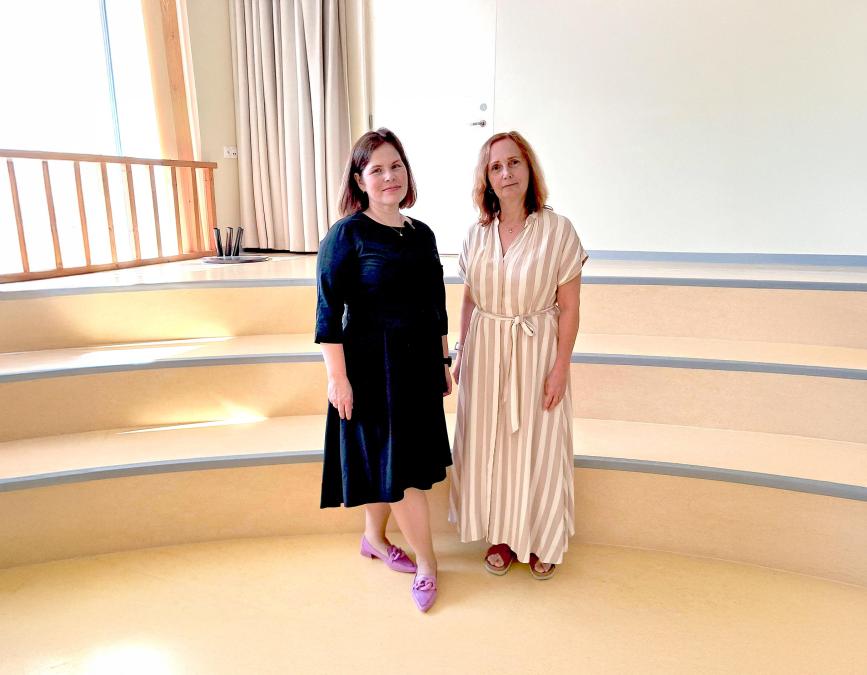The Kindergarten of the Future – from a former garage to the heart of the community
The history of the Future Kindergarten building is as diverse and exciting as the people who work there every day. Originally built in 1975, the building was not intended for a kindergarten. The building has housed a branch of the Estonian Agricultural Research Institute (ARI), a squash hall, and a dental clinic. The place, which locals still call “ARI House,” has played many roles over the years and gained a completely new life 12 years ago, when the building was renovated into a kindergarten in just four months. Interesting fact: the current hall was previously a garage through which cars drove in. Now this space is filled with children’s laughter and a passion for learning.
The specifics of the building have given the kindergarten a unique look: no two group rooms are the same, some groups don't even have their own wardrobe, and some rooms have been adapted for completely unexpected purposes. For example, the former cleaning supplies and laundry warehouse has become the head teacher's room. The playground is also not next to the house, but across the road. But as the kindergarten director says: "You shouldn't judge a book by its cover - and you shouldn't judge a kindergarten only by its facade."
Since 2016, Tuleviku Kindergarten has been an independent institution. It was from that moment that a conscious journey began in shaping its image and values, both in name and in actions. The kindergarten, named after Tuleviku Street, has woven this meaning into its vision and daily pedagogy. It implements project-based learning, values flexibility in terms of both children's sleep needs and teachers' work arrangements, and believes that community is not something that comes from outside, but is born from the contribution of every child, teacher, and family.
The interview was attended by the director of Tuleviku Kindergarten, Maiki Vanahans, and the head of studies, Katrin Larm.
From left: Maiki Vanahans, Rasmus Gross, Katrin Larm
What is the history of the Tuleviku Kindergarten building and how has it changed over the years?
Our kindergarten building was originally built in 1975 and was renovated for the children 12 years ago. The renovation was done quickly, in just four months. An interesting fact is that the hall where we are standing now was once a garage. Instead of windows, there were garage doors from which cars drove in. This building has housed a branch of the Estonian Agricultural Research Institute (PRIA), a squash hall, a dental office... locals still call it the “PRIA house”. The facade was given a new coat in 2019. Before that, the building was covered with gray dolomite stones. Unlike most kindergartens in our area, this building was not originally designed as a kindergarten, for example, our playground is located across the road, not next to the house. However, I believe that just as you shouldn’t judge a book by its cover, you shouldn’t judge a kindergarten by its facade.
When did Tuleviku Kindergarten become an independent institution and how did this development proceed?
The kindergarten operated as a branch of Nõlvaku Kindergarten for three years. Since 2016, it has been an independent kindergarten and I started here at the same time. This period has been exciting and developing. The name of our kindergarten often raises questions. People think that it is a private kindergarten or that we have some specific direction. In fact, the name is very pragmatic. We are located on Tuleviku Street, and that is where “Tuleviku Kindergarten” comes from. However, we have integrated this name into our mission, vision and core values. We use the kindergarten name consciously and meaningfully.
What are the spatial characteristics of Tuleviku Kindergarten?
It is not a typical kindergarten building. We do not have any group rooms that are exactly the same. There are group rooms that have only one large room and others that are multi-room. Some groups do not have a wardrobe inside the group room at all, but it is located elsewhere. One of the former laundry rooms is now our head teacher's office. The speech therapist has her own office, and the room that used to be a squash hall is now one of our group rooms. Every room is really different, which makes the environment exciting and flexible.
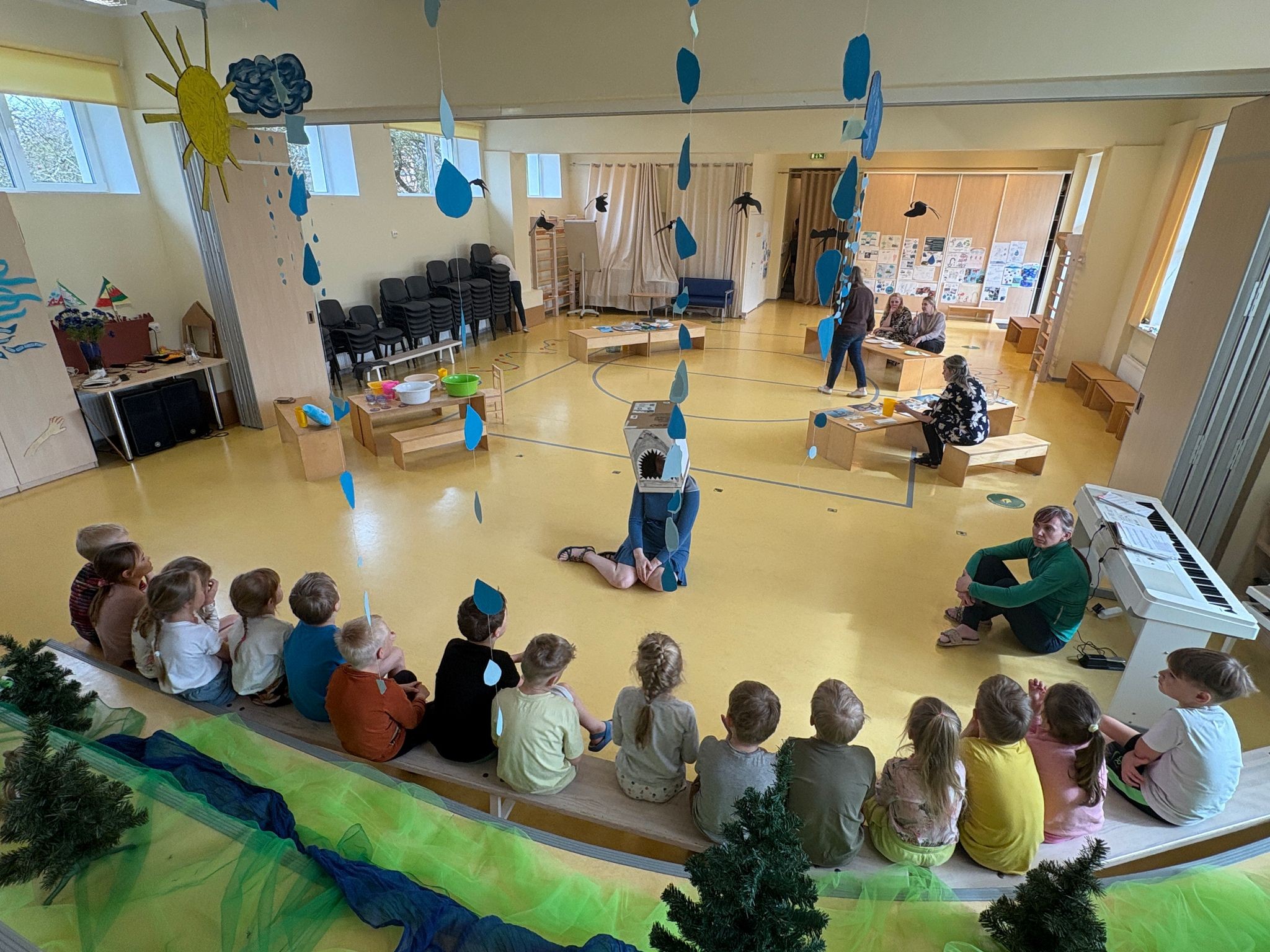
What is the role of project learning in Tuleviku Kindergarden?
We have been implementing project learning in all groups since 2018. We have painted the entire inside of the building in one color so that the walls act as a canvas. The results of the learning process and children's creations can be displayed on the walls. In September, teachers map the children's interests and play topics, and project ideas are developed based on them. The groups have activity centers that allow children to make choices and support consideration for each other. In addition, we have group names related to the name of our kindergarten. The first letters of the group names form the word "Future", and the seventh group, called "Cosmos", brings together the management team and specialists such as a music and physical education teacher.
How is the lunch break for children organized at Tuleviku Kindergarden?
We have found a flexible solution for the lunch break. We do not call it bedtime, but rest time. If a parent indicates in ELIIS that they do not want their child to go to bed at all, we do not direct them there. If the parent wants the child to try to sleep, but they do not fall asleep within half an hour, the child is allowed to get up calmly and do something. We do not force anyone to lie in bed. We have a watch schedule between groups, based on which teachers watch the children during the break. As a new idea, we have discussed that perhaps children should not change clothes for the break at all. The beds are made up and anyone who wants can simply rest. We want to move away from the old forced sleeping culture and offer the child a choice.
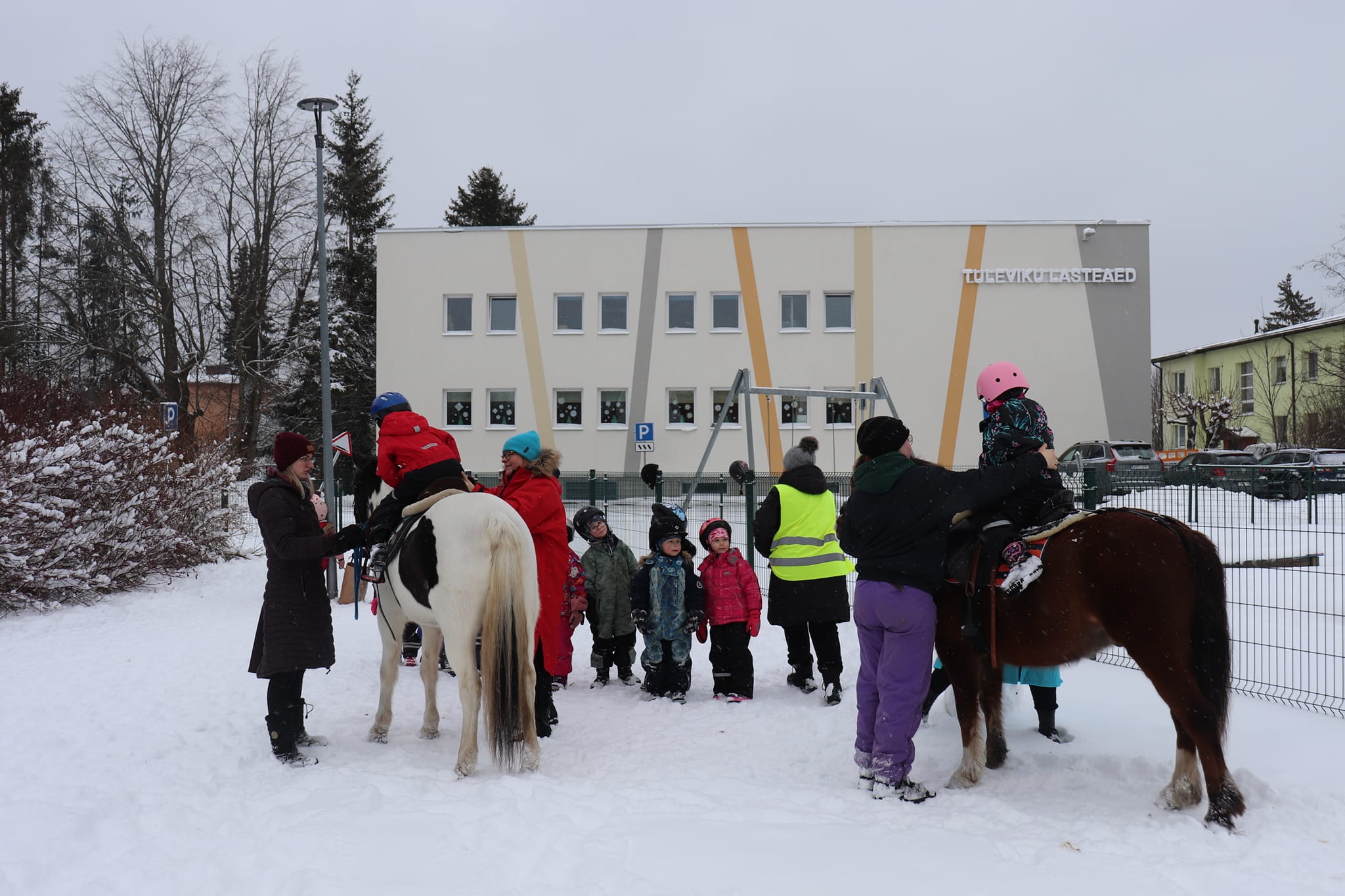
Is the topic of recess and sleep time in kindergartens overblown in Estonia?
Yes, I think it is overblown in some ways. Perhaps our own resistance, as kindergarteners, also plays a role here. If we stand strongly against something, it creates more resistance on the other side. The laws of physics, right? Resistance creates resistance. However, it is important to ask: if the law says that a child must have a choice whether to rest or not, then who actually has that choice, the parent or the child?
How is the decision about when a child should sleep? Are you more guided by the wishes of the parent or the child?
There are parents who say that they want their child to go to bed during their sleep, even if the child at home says that others are not sleeping and that they don't want to either. It's a difficult balance. We are often given the example of Scandinavian countries, where children don't sleep in kindergarten, but the kindergarten day ends much earlier, for example at three or four o'clock. Our goal has been to find a way to engage parents in a dialogue on this topic and to explain the broader picture so that parents can make an informed choice based on their child.
What was the feedback from parents when you introduced a more flexible approach to recess?
The idea of a flexible recess arrangement was driven by conversations with parents. However, when we started last school year with the idea that children don't have to sleep and parents can make a choice about this in ELIIS, one parent was very surprised. She had a preschooler and she asked: "How is that? Why don't we have naps in your kindergarten anymore? Is it really that no one is sleeping?" It turned out that her child was talking at home that no one in their group was sleeping, and this worried the parent. This shows how important it is to communicate openly with parents and explain what we are doing and why.
What are the opportunities and challenges for Tuleviku Kindergarten regarding the playground?
Our playground is located across the road and is public. The playground belongs to the community, not just our kindergarten. We share it in cooperation with local residents. The playground is divided into age groups: in the front for younger children (3–5 years old) and in the back for older children (5–7 years old). Although sometimes there are situations where parents with small children end up in the area intended for older children, we have generally managed well. For example, on bike days, confusion can arise, but we try to prevent situations and resolve them amicably.
What is the spatial structure of the Kindergarten of the Future and how does it support learning activities?
What is great about our kindergarten is that the group rooms are very different and you can move around in circles. Our spatial specificity is a gift to us on the one hand, but also a challenge. Each group has its own personality. Since we do not have so-called “free” rooms, we have had to find smart solutions, for example, the project walls in some groups extend across the entire room.
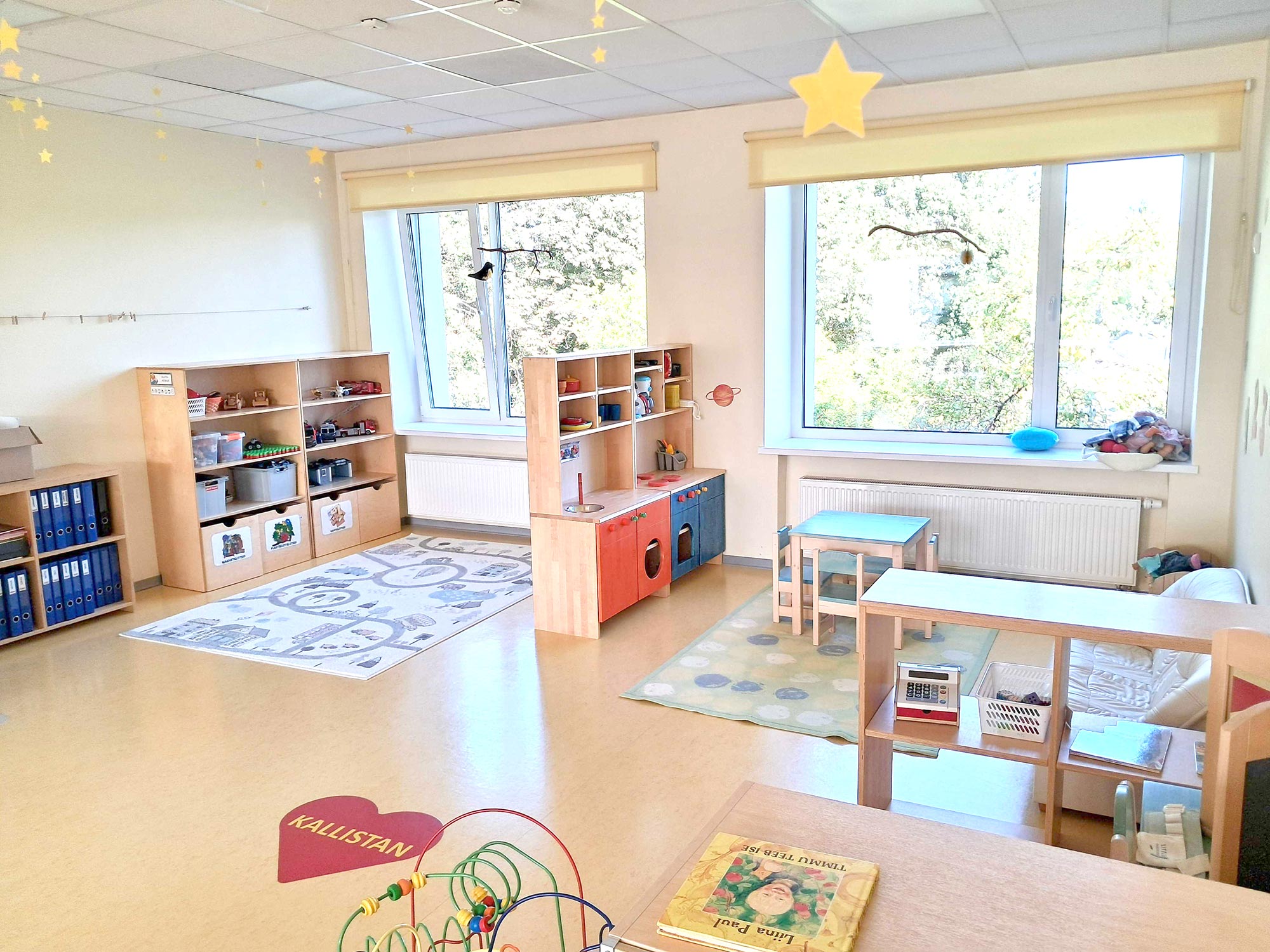
How has the staff's workspaces developed in recent years?
In the early years, we did not have a study kitchen or proper workspaces. Over time, in cooperation with the municipality, we have added a study kitchen and specialist offices. For example, for the head of studies, music and physical education teacher. We now also have a nice study room where it is good to be. The municipality has been understanding and supportive. They have been thoughtful and have found opportunities. I am very happy about that.
Does every kindergarten have its own face, even if the buildings are similar?
Absolutely. Even kindergartens with a standard design have their own personality. Each institution reflects the values, choices and collaboration of the people who work there. I have visited many kindergartens over the years and each time there is something special. This is what makes these places lively and unique.
How did you experience your first contact with Eliis and what was your first experience with the system?
My first contact with Eliis was in Jõelähtme rural municipality, when I worked there as a kindergarten teacher. It was probably around 2012. We even had a meeting with the Eliis team. Later, while working in Viljandi, I implemented three different e-kindergarten environments as part of a test period, and Eliis turned out to be the most user-friendly. Then I also implemented Eliis in Viljandi.
How does Tuleviku Kindergarten use ELIIS and what are your experiences with the system compared to other kindergartens?
When I came to work at Tuleviku Kindergarten, Eliis existed, but it was not actively used. Then we decided with the board of trustees that all information exchange would take place only through Eliis. The website remained static and all daily information such as announcements, menus, events moved to Eliis. Thanks to this decision and also to the developments in Eliis, this system has become an indispensable tool for us. Today, we use ELIIS very actively. Our kindergarten teachers can also change their work schedules themselves if they agree among themselves. The director does not have to approve every minor change. This is efficient and flexible for us.
How do teachers feel about ELIIS platform?
Our teachers really appreciate the image and video gallery. It allows you to document the learning process and the child's development in a very visual way. However, it should be borne in mind that all information shared there must be in accordance with the Personal Data Protection Act.
What is your experience with involving parents in ELIIS platform?
At first, it seemed like an additional responsibility for parents. Today, the situation is different. Parents appreciate the opportunity to report absences easily and quickly, receive all notifications to their email, and know how to use the system. We have held a meeting for parents of children starting school every summer and autumn, where we introduce Eliis to new families and teach them how to use it. Parents have become very active.
What role do teachers play in Eliis content creation?
If photos, descriptions, children's words or small moments from the day are added, then parents are more involved. Eliis has given us the tools, but we create the content ourselves. If teachers do not contribute to the creation of content, the platform cannot function optimally. If information, pictures, development maps and messages are shared regularly, then parents will also use and appreciate it. And the more the system develops, the better we can involve parents.
What is your experience with ELIIS customer support?
We have had a very good experience. If the phone is not answered, they always call back. The customer support specialists are calm and supportive even in difficult situations. We feel that we are taken seriously and heard.
How has your kindergarten provided feedback to ELIIS regarding developments?
I always have a draft letter where I collect thoughts and send them all at once if necessary. I have called several times and explained ideas during the conversation, which have been very friendly received. For example, we currently feel that the work schedule module needs to be improved.
What is your suggestion for improving the functionality of the work schedule module?
It would be very useful if the standard hours were adjusted automatically when an employee adds a vacation or sick leave to the system. Currently, the teacher has to calculate how many working hours they should actually have. Since teachers plan their own working hours, they need an accurate overview so as not to overplan or underload.
How have you adapted ELIIS working time types to your work organization?
We have created different types of working time: substitutions, training, parental leave, paid time off, etc. Substitutions are not included in the calculation of working time, but are noted separately. Training and parental leave are included in working time. The system works well, but the complexity arises especially in the case of holidays related to calendar days, where the number of standard hours does not adjust automatically.
Is ELIIS also used as a communication channel in your kindergarten?
Yes, completely. We do not use Facebook groups or Messenger in any of our groups. I also told the teachers at the beginning that parents will not use Eliis if there are parallel channels. All communication goes through ELIIS. Pictures, announcements and other important information are only shared there. This helps keep communication organized and transparent.
I know that your kindergarten started Smart Adventure. What is Smart Adventure (Nutiseiklus) and how did it start?
Smart Adventure started in the spring of 2018 as an event at our own kindergarten. It was related to the theme of Jury Night and initially took place as a smart run. Families adventured between points where tasks were hidden under QR codes. Over time, it has grown larger and become a community event.
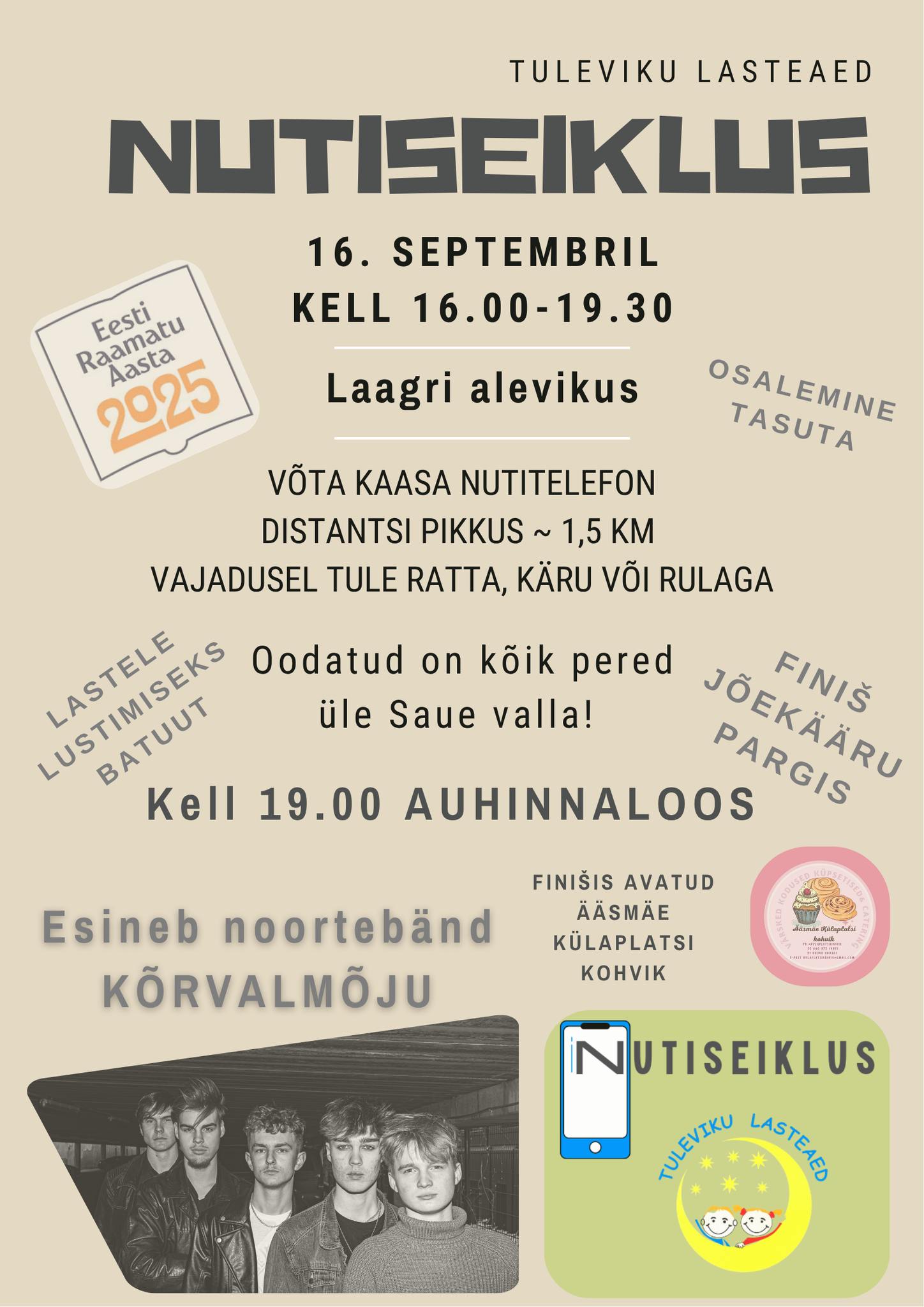
How has the Smart Adventure developed over the years?
Initially, we organized everything ourselves, but since 2019 we have also invited other kindergartens in the area to participate. In the spring of 2020, the corona pandemic came and the event was postponed to the autumn. Then we also involved other kindergartens in the content creation. Each kindergarten prepared its own point. The tasks were under QR codes and included, for example, movement, poetry and robotics. Each family could start the adventure from a point that suited them. Initially, each point was also a finish, but in the last four years, the finish has been separate to reduce the load at the points and better manage activities. Previously, we have drawn sponsor prizes among registered participants by doing a live broadcast on the kindergarten's Facebook page a few days after the smart adventure. In the last two years, when the event has grown larger and we have moved the finish to Jõekääru Park, we drew sponsor prizes at the end of the event. Smart Adventure also has smart diplomas hidden under a QR code.
How have you connected education and community through Smart Adventure?
It is important for us to connect movement, spending time together, the Ministry of Culture's theme year, and the digital competences of children and staff. The event is not just for kindergarten children, it is intended for the entire community. For example, last year the finish was in Jõekääru Park, where a youth band performed, there was a trampoline, catering, and people also came to just explore. This has been a passion of mine. The goal is to create a free, inclusive community event where everyone is welcome.
How does cooperation with sponsors work within the Smart Adventure?
It has been difficult with large companies. Many do not see a small local event as their focus. I have written to many large companies, who responded politely, but were not interested. Rather, smaller and local companies have supported us. Large companies want to know about things at least a year in advance when making sponsorship decisions.
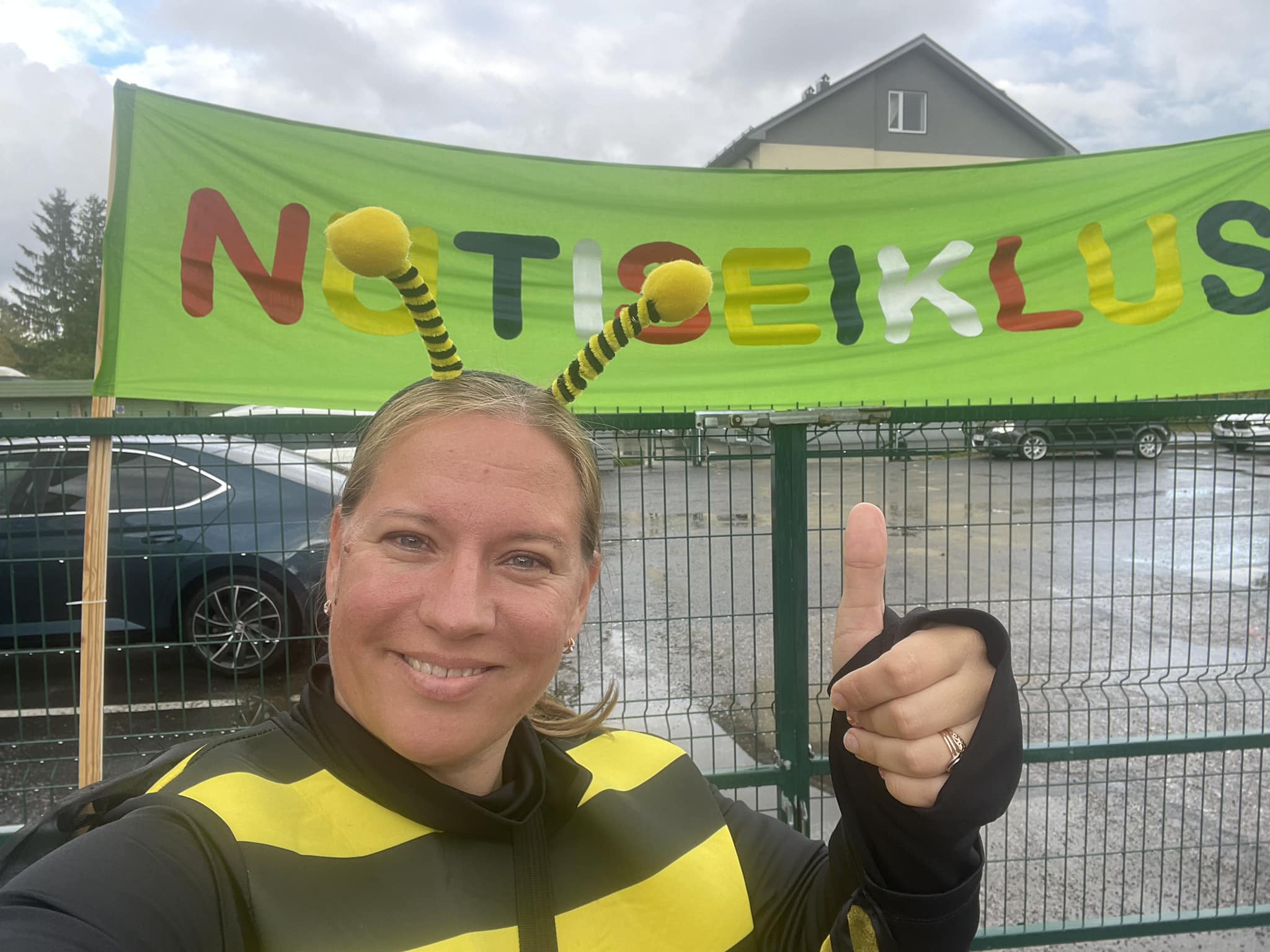
What are your future plans for Smart Adventure?
We want to engage the community even more and develop the event further. We want it to meet the expectations of the community and be interesting for everyone, regardless of whether the child attends our kindergarten, another kindergarten, or not at all. We will involve more supporters, improve the organization, and keep the focus on movement, technology, and shared values. It is important for us that the event supports a sense of community and creates an opportunity to be together.
Has Tuleviku Kindergarten been involved in larger community projects before?
Yes, two years ago we participated in Eliisi's Christmas campaign, where our entire community was very actively involved. Under the leadership of our kindergarten music teacher, we created a winter wonderland in the kindergarten, from which one of the teachers, who had previously studied media, quickly put together a very engaging video. We really had a strong feeling that the entire community was with us.
What was this specific campaign and how did you participate in it?
It was a winter and Christmas decoration campaign organized by Eliisi. The participants were various kindergartens, whose videos and pictures were posted on Facebook. The winner was the video/picture whose comment received the most "likes" by a certain time. We did very well. Families shared the video, friends, relatives, acquaintances, and the entire community became active. During the last hours, there was a real "vote battle" between us and Aruküla kindergarten.
Did Eliis take into account the tight final competition and react to it in any way?
Yes, Eliis behaved very nicely. Since the counting of votes was really tight and difficult in the final minutes, they decided to give two main prizes. It was a nice and fair solution. It didn't even matter to us who won in the end. What mattered was that the community came together and we felt supported.
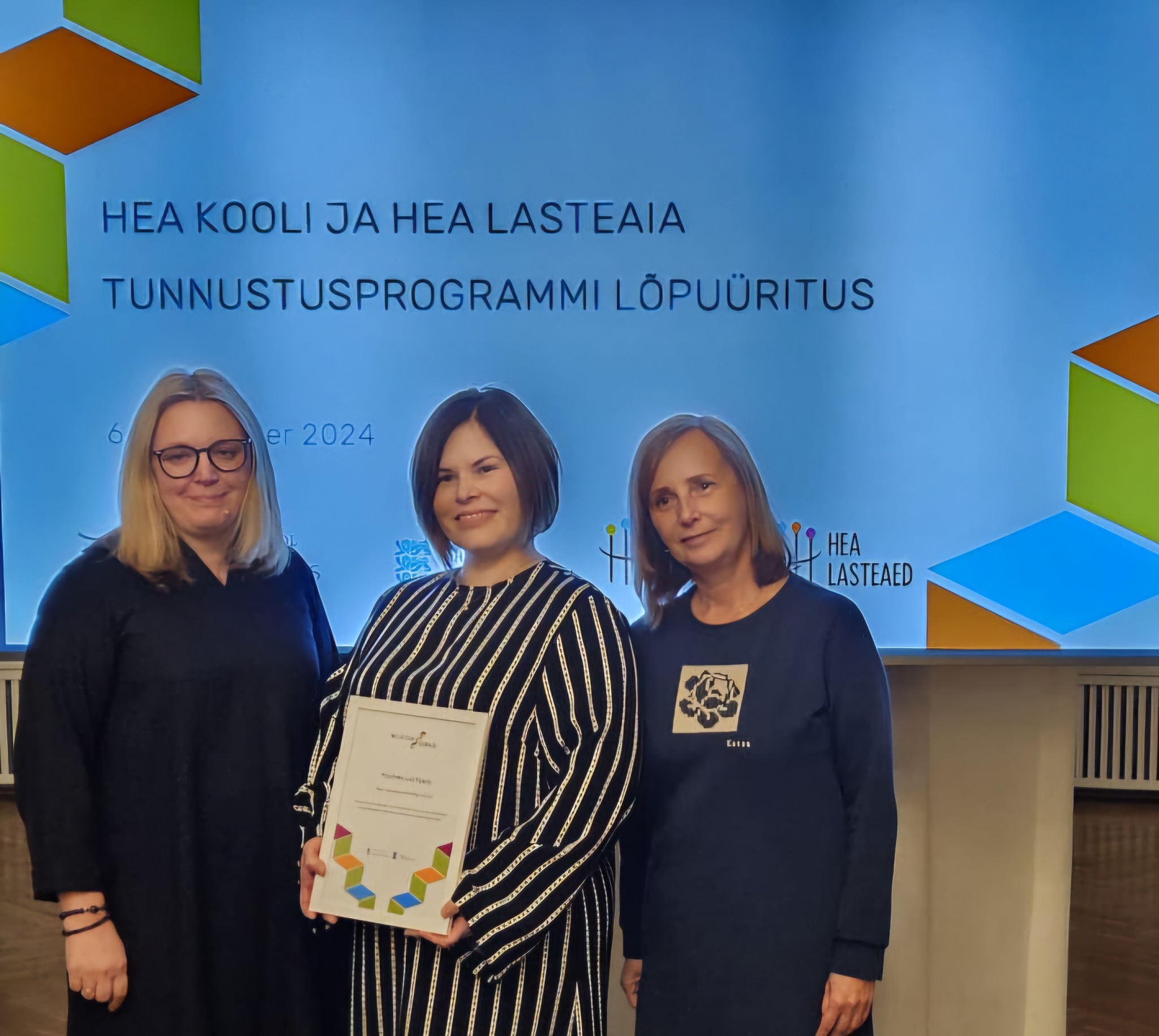
How would you characterize the role of the community at Tuleviku Kindergarten?
The community has always been very important to us. We see the kindergarten as a community center, not only for the children who attend it, but for the entire region. We have good cooperation, for example, with the state gymnasium, which, as part of its community day, sends young people to learn about the work of a teacher in the kindergarten. For example, we also have good cooperation with the local dental office, where the dentist checks the dental health of our kindergarten children once a year. We want the kindergarten to be an open and inclusive place where everyone is welcome. Regardless of whether the child's family is part of our kindergarten or not.
What are your thoughts on the role of kindergarten in the wider community?
For me, it is important that the relationship with the community is reciprocal, that we not only open our kindergarten doors to the community, but that the community can also give something back. For example, Smart Adventure has involved food trucks from local businesses, youth bands and a number of volunteers. This all supports the feeling that kindergarten is not a closed system, but a living part of the surrounding society.
I am aware that you have been actively working on your doctoral thesis recently. Does your doctoral thesis also concern the community?
My doctoral thesis focuses on culturally sensitive teaching. One of its central components is community involvement, and not only in terms of families, but more broadly. For example, the American-origin culturally sensitive teaching model emphasizes that the community is part of a child's developmental environment. In Estonia, attempts have been made to implement this, for example, under the inclusive school model, but it is not very widespread. My work seeks to bring more awareness and attention to the fact that kindergarten can also be a place where community and education create a strong network together.
How did you come to the topic of culturally sensitive teaching?
In 2017, Tallinn University held a pre-doctoral study program where different research directions were introduced. There, Professor Aino Ugaste, who had also been my lecturer, contacted me. She offered me the opportunity to delve into the topic of culturally sensitive teaching. Since I had previous experience working as a teacher and leader in a multicultural environment, it seemed like a very natural and meaningful choice. Eventually, this became my research focus.
Who is your doctoral thesis aimed at and what did you research in more detail?
My work focuses on teaching new immigrant children in Estonian kindergartens and schools. The focus is on the views, experiences and practice of teachers and leaders. However, it can also be extended to teaching children from other cultural and linguistic backgrounds. Even seemingly "homogeneous" groups are never truly homogeneous. Each child comes with a different experience, language use and cultural background.
When did you defend your doctoral thesis?
I defended my doctoral thesis on September 3. It was a long and meaningful journey, eight years of work, but now it's done.
Congratulations on successfully defending your doctoral thesis!
Thank you! It was a great moment and I am very grateful to everyone who supported me on this journey.
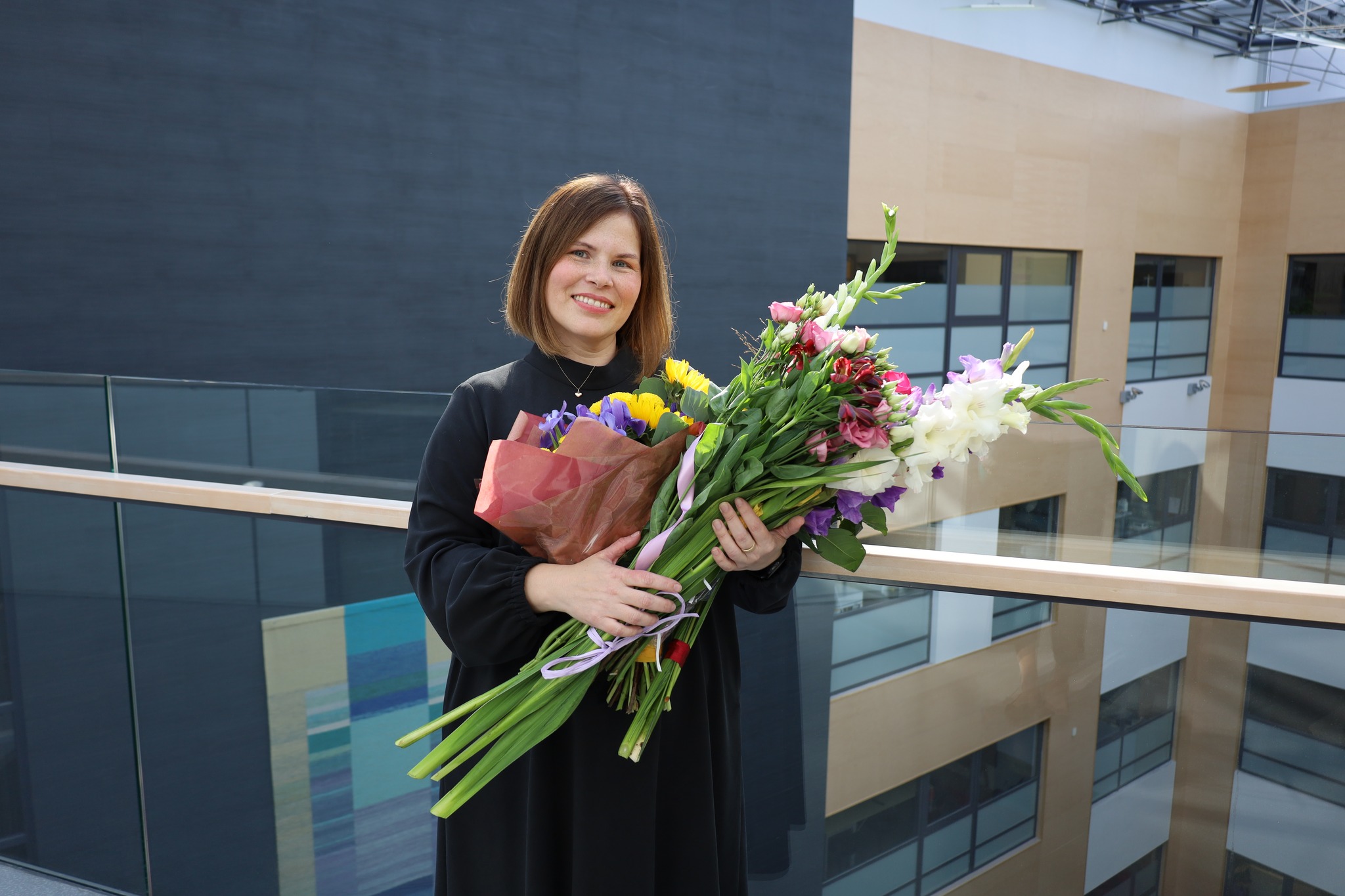
What has been the feedback on your doctoral thesis?
So far, there hasn't been much direct feedback, but the general discussion in society shows that the topic resonates. Although my research focused on teaching new immigrants, it is also related to multicultural education and community engagement more broadly. For example, the arrival of war refugees from Ukraine brought several issues to the fore. Some people are concerned that paying attention to others may come at the expense of "our" children. These are legitimate concerns. But I emphasize in my work that culturally sensitive teaching does not mean favoring one group. It means equal opportunities for all children.
How would you describe the structure and methodology of your doctoral thesis?
The work consisted of three stages. First, I conducted a quantitative study, where teachers assessed their own knowledge, attitudes and skills regarding culturally sensitive teaching. This was followed by a qualitative stage with interviews with teachers. With those teachers who were willing to share their experiences. In the third stage, I interviewed the heads of these same schools and kindergartens to see how teachers and newly immigrant families are supported at the management level.
What important conclusions did you draw from these interviews?
First, it became clear that teachers have a very high workload and need more support. Although the media talks about the high average salary of a teacher, no one actually gets that salary full-time, it comes with additional responsibilities. It was heartening to see that several leaders had tried to create support for teachers within their means. For example, some schools and kindergartens were able to hire additional resources, either assistant teachers, teachers of Estonian as a second language, or even create a new position, such as a new immigrant coordinator . This is an excellent example of how structural support can be created within the system.
What role does collaboration between teachers play in a multicultural learning environment?
It is key. In some institutions, collaboration between teachers was formally planned into their workload, for example through collaboration time, study circles or experience exchanges. It is important that it does not remain just a voluntary activity after school, but is systematically supported.
Do you think schools and kindergartens currently receive enough support from the state level?
At the moment it seems rather not. Each institution needs to build its own system and find solutions. There could be more coordinated support, clear guidelines and resources at the state level, especially considering how diverse today's classes and groups are.
What aspect of your doctoral thesis surprised you the most?
One of the biggest surprises for me was the culture-blind attitude among teachers and leaders. This may seem positive on the surface. For example, people say: "a child is a child" , "we don't make a difference" , "a person is a person" . But in reality, this often means that differences are perceived, but they don't know how to consciously deal with them. It's like a defense mechanism. No one wants to intentionally hurt anyone, but looking for a common "golden mean" can instead create a situation where no one is noticed or supported enough.
It is particularly problematic when this attitude is also applied in completely Estonian-speaking groups, where the social and cultural backgrounds of the children can still vary greatly. So “one size fits all” does not work, whether the child is a new immigrant or not.
Did anything emerge from the leaders' attitudes as well?
Yes, definitely. Although all the leaders I spoke to valued multiculturalism and expressed openness to new immigrants, this mindset was often not reflected in documentation, such as development plans or curricula. Many saw support for new immigrants primarily as a language issue. The focus was on teaching Estonian as quickly as possible.
But this approach carries a risk. If we focus only on language learning, it can turn into assimilation, not integration. We cannot expect a new immigrant to simply “become Estonian.” Rather, we should help them understand and cope in the Estonian cultural space, while preserving their culture and identity.
This all sounds quite complicated for a teacher. How should a teacher cope with this situation – especially when there are several children from different cultural backgrounds in the group?
This is a big challenge. An Estonian teacher is used to talking about our own traditions – national symbols, foods, holidays. Now, if a child from Ukraine or Georgia comes to the group, then even if the teacher wants to include the cultures of these children, he or she may not have the knowledge or skills to do so.
My advice would be: don't be afraid to ask and investigate. Even a small step, such as asking a parent what holidays they celebrate at home, can be a big help. In addition, teachers should be systematically supported through training. Teachers do not have to "invent the wheel" themselves, but they should be provided with tools and support. Teacher training must also take into account a multicultural learning environment from the very beginning, so that such knowledge and attitudes are a natural part of the teacher's professional base.
Does a teacher need to know all cultures in depth to support a child and family?
No. A teacher does not need to study all the world's religions and cultures at university. What is important is a broader cultural awareness and understanding that culture means more than language or nationality. We all know these stereotypes. For example, that all Estonians eat sprat sandwiches, but we also know that they are not true. The same applies to other nationalities.
So I recommend to teachers: if a child from a different cultural background comes to the group, it is best to talk directly to the family. Find out what is important to them, what are the home values, principles of upbringing, anniversaries celebrated. Families from the same country, for example, can be very different and cannot be generalized.
What could be the first step for a teacher to establish good contact with a family?
In our kindergarten, every teacher has an introductory conversation with a new child's family. Even if the child is Estonian-speaking, it is important to understand the family's values and upbringing principles. This contact can determine how easy or difficult the teacher's job will be.
A good relationship with the family helps prevent misunderstandings, builds trust, and reduces confusion. And while it may seem like it requires extra work and time from the teacher, in the long run it actually makes their daily work easier.
How can a leader support a teacher in multicultural work?
I think it is important that a leader does not simply throw a teacher “into the water” and say, “Now swim.” In our kindergarten, I am the first to meet new families. I am the first to introduce them to our education system, kindergarten principles, and we create an Eliisi account together with the parent. All of this takes a lot of work away from the teacher.
In addition, teachers need to be offered in-service training and opportunities to exchange experiences. It is very important that teachers can hear how others have acted in similar situations and also get some theoretical background.
Are there any supporting materials and tools in Estonia for teachers who work with new immigrants?
Yes! For example, Jane Möll, who worked at the Tarekese kindergarten in Haapsalu, created an environment as part of her master's thesis. terelasteaed.ee . This website explains the Estonian kindergarten system in Estonian and English. It is a great resource to help teachers and families.
Although such tools are useful, it is important to remember that each case is unique. One cannot assume that the same approach will work for every family. This was also confirmed by the teachers who participated in my doctoral interviews. It always needs to be adapted and taken into account for the specific child and family.
How do you assess Eliis's language range and its role in a multicultural learning environment?
I think Eliis already has a pretty wide range of languages and that's a great thing. I've had situations where I've sat with a Ukrainian parent. Some families speak Estonian, but there are also those who don't speak it at all. In such situations, it's very important that the platform is also available to these parents.
What are the biggest challenges in communicating with parents when there is no common language?
A big problem arises when a child learns Estonian faster than their parents, but still communicates with the parent at school or kindergarten. And if they do not have a common language, it is difficult to communicate on educational and organizational issues.
One great example came from a school where students were allowed to do written work in their native language. The condition was that they also write a short summary in Estonian at the end, for example three sentences. Teachers assessed this work with Google Translate, which gave them a general idea of whether the child had understood the topic. This is a good example of flexibility.
Are similar language-supporting solutions implemented in kindergarten?
Of course, there are no written assignments in kindergarten like there are in school. In kindergarten, learning is more through play and experience. But it is precisely playful learning that allows language to be better linked to real-life activities: a word is linked to a picture, object or activity. Such a connection helps a child to acquire language better.
Do you believe that the results of your doctoral thesis will be applied in the Estonian education system? For example, will the ministry or universities take them into account?
I would really like to hope so. I see that the issue of multiculturalism is being addressed at the state level, but the focus is very strongly on teaching the Estonian language. Of course, teaching the Estonian language is very important, no one disputes that. But if we consider a child's academic success only through Estonian language skills, then this is not enough.
Studies show that Estonian language skills alone do not guarantee a child’s success or sense of success in their studies. A child also needs their cultural background to be taken into account in the learning process. We cannot simply teach “the curriculum”, we must teach the child. We must find a way to make this curriculum understandable and meaningful to them. If we do not find this way, then language skills alone will not help.
Is there anything that surprised you negatively while doing your doctoral thesis?
Yes, one of the biggest negative discoveries was related to the topic of culturally sensitive teaching. When I started, I thought that it had only been talked about for the first time in Estonia around 2018, when Tallinn University and the University of Tartu participated in the RITA migration project. It was a broad interdisciplinary project involving different fields – sociologists, educational researchers and others.
But while doing background research for my doctoral thesis, it became clear that culturally sensitive teaching had been discussed in Estonia much earlier. I was even surprised when I found a collection of the VERA project from 1998, where the topic of culturally sensitive teaching had been discussed. This discovery was surprising to me, because we have been having these discussions for a long time, but on a larger scale, this topic has not yet really taken root in educational policy. This shows that we tend to keep such important topics at the project level. They do it, they talk about it, but the actual impact does not reach practice. This is a big problem.
In your opinion, should culturally sensitive teaching also be more strongly incorporated into teacher training at universities?
Yes, definitely. I work as a lecturer at the University of Tartu myself and I know that subjects have to compete with each other in the curriculum – mother tongue didactics, general pedagogy, all important subjects. But the question is, where does culturally sensitive teaching fit in? This way of thinking should permeate all teacher training. Similar to how it is said in the case of LAK education that every teacher is a language teacher, in a multicultural society we should also think that every teacher is also a shaper of intercultural awareness.
Does the teacher professional standard reflect the competence of culturally sensitive teaching?
Unfortunately, no. The teacher professional standards were just recently updated, and to my great sadness, even the small thing that referred to taking cultural background into account has been removed.
At the same time, for example, digital competences are strongly emphasized, but the teacher's intercultural competence, which includes attitudes, knowledge and skills in a multicultural learning environment, has completely disappeared. And this is very worrying.
Do you have any idea why the intercultural competence of teachers was excluded from the professional standard for teachers at all?
To be honest, I don't know. And this is one of the reasons why I hope that my doctoral thesis could reach decision-makers more widely. Just as you shared Eliis' story with me before the interview began, how you didn't give up and invested your time, energy and money, I feel the same way about my topic. I know that changes don't happen overnight. Culturally sensitive teaching has been talked about in Estonia since the late 1990s. And yet, in the 2020s, we still encounter it as some kind of new and incomprehensible phenomenon. But we must not lose hope.
In your opinion, is the content of a teacher's work similar regardless of the region?
Broadly speaking, kindergarten life is still kindergarten life. But differences come into play, for example, in leadership styles and organizational culture. Each leader develops their own style over time. Personally, I strongly believe in teacher autonomy. Our kindergarten has clear principles, but in project-based learning, for example, we do not dictate the exact form. Each group works at its own pace, according to the specifics of its children and families.
So, the transition to project-based learning doesn’t happen overnight?
No, definitely not. Especially if you want to do it in partnership, not in a top-down command. For me, that’s not a leadership style. Project-based learning, teacher autonomy, community involvement – they all require trust and continuity. One big project doesn’t grow big without long-term commitment. Similarly, culturally sensitive teaching won’t take root if we don’t create an environment, support, and understanding for it among both leaders and teachers.
There has been a lot of talk lately about merging kindergartens. The birth rate is falling, and people want to save resources. Tuleviku Kindergarten was once a branch of Nõlvaku kindergarten. Do you see a possibility that it could become a branch again in the future? How would you feel about that?
We currently have two kindergartens in the municipality, with two buildings under one director. I myself have never really thought that our kindergarten could ever become a branch again… I don't know what I would do then. To be honest, I am the biggest fan of this kindergarten. I like this kindergarten just the way it is. Maybe that's why it hasn't been easy for others to love this building right away. But you can't force something to be cute. You have to show what the content of this building really is, and that's really cool.
Our teachers do a wonderful job and the parents are very involved. For example, last year we decided not to do a traditional Christmas play, but to create a big “Future Christmas Village” outside together. We didn’t have enough outdoor lighting, so we put out an appeal and the parents brought their own outdoor lights. The municipality administration helped us with the electrical connections. One parent who has an alpaca farm even brought three alpacas! We had different activity points, Santa’s room, an elf cellar play, an angel craft room, an outdoor kitchen where you could grill wieners… It was just an incredibly warm and communal moment. And in the evening, messages came through Eliisi, where parents wrote that it was the best Christmas party of their child’s life.
But how do you assess a situation in terms of management where one manager has to be responsible for several kindergartens or houses?
I haven't experienced it, but I've always wondered what I would do if I were at the head of such a system. If a new house comes along, the construction and team of which are put together from scratch, then it is certainly easier. But if there are two kindergartens that have operated completely independently and they are merged, then it is a completely different situation.
And the situation is made especially difficult when a person who previously led one of the houses being merged is appointed as one of the leaders. In this case, it can easily create a feeling that “we do it this way, now you have to do it that way”, but that doesn’t work. Each house has its own story, its own culture, its own habits. And I don’t believe that there is one “right way”. There are different options and they have to be handled sensitively.
What is your opinion on the organization of teachers' work? Which system works better in your experience: 2+1 or 1+2?
In my opinion, it is not the system that works, but the people. If teamwork does not work, then it does not matter whether you have 2+1 or 1+2 - there will be no result. As of this year, all our groups are again in the 2+1 system, but in previous years we have also had a 1+2 system in two groups.
We didn't do it to save money, we just didn't have enough teachers to apply. But we had work to do, so we decided to find really good assistants, and we were really lucky. Fortunately, our local government hasn't pressured us to have all the groups in the 1+2 system.
Do you see any differences in how teamwork works depending on the work organization?
I don't. If people get along well with each other and cooperate, it doesn't matter which system it is. And at the same time, I have also seen such arrangements where there is 1+1+1, i.e. teacher, assistant and teacher's assistant. For example, there the teacher's assistant has fixed working hours, while the teacher and assistant work in shifts.
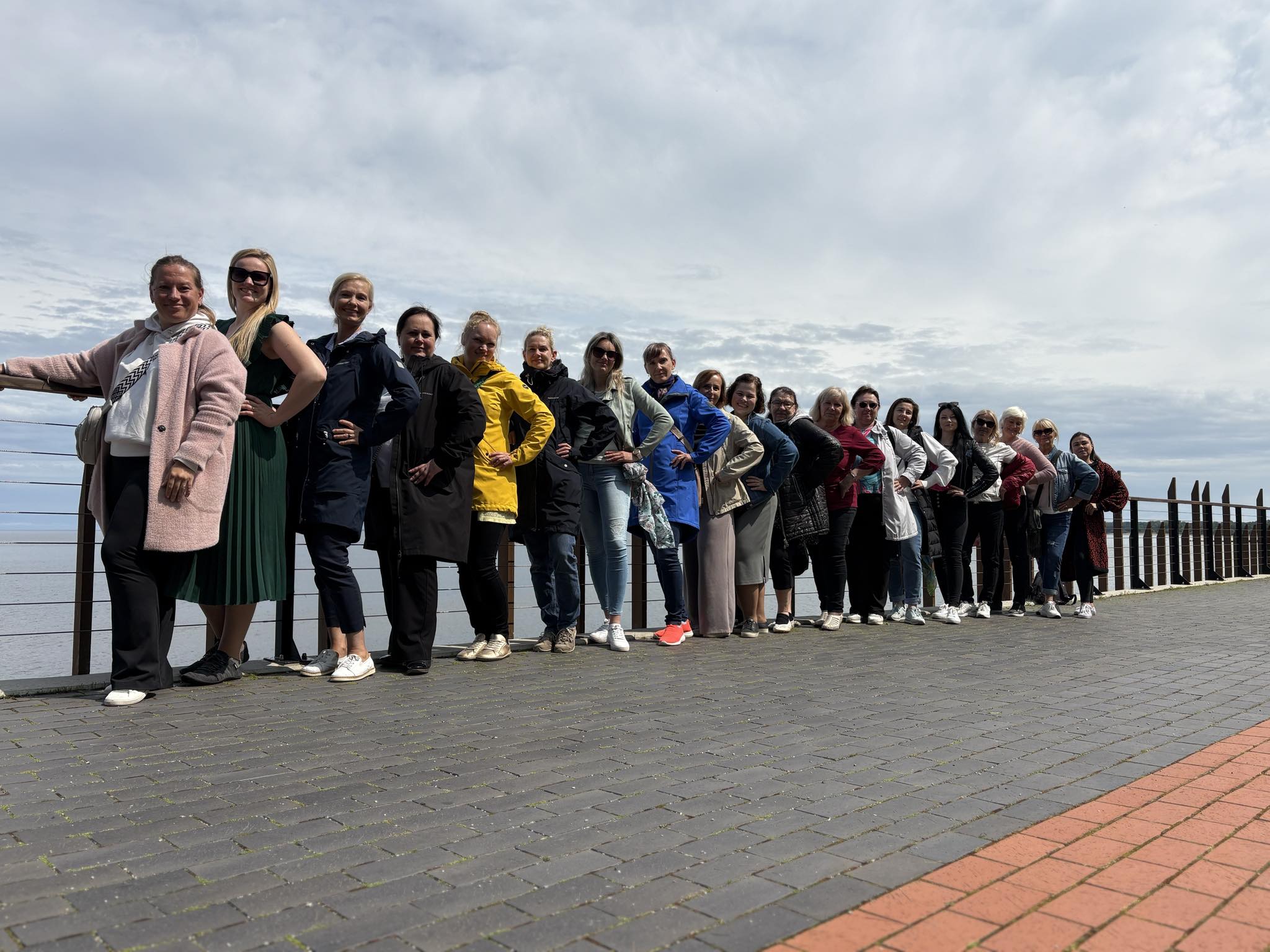
What is your experience between two-teacher and one-teacher systems? What differences have you noticed?
Our experience shows that the most important thing is not the system itself, but the people who work in this team. In a 2+1 system, the teacher's workload is definitely lower. For example, if 24 school readiness cards have to be filled out, then the two of you can share, discuss, and complete this work. It's a completely different burden when you're alone.
Does a teacher have more leadership responsibility in a one-teacher system?
Certainly, but this must also be supported by the management. A one-teacher system requires very good teamwork and the teacher must be able to direct his team in such a way that the assistants are a real support to him. But the leading teacher is not the boss of his team, they are rather partners in cooperation. If this feeling and mutual respect do not exist in the team, then the system will not work either – regardless of whether it is 1+2 or 2+1.
What impact does teacher autonomy and the role of the local government have on such work organization issues?
Local governments have different approaches. In some places, the kindergarten itself decides which system to use, in other places the decision comes from the manager. In our municipality, kindergartens have the right to choose, and this allows them to flexibly adapt to the situation. For example, if there are no teachers to hire, there is no point in sticking to just one system. What is important is that the work gets done, the child is cared for, and the teacher is not overloaded. This is one of the biggest challenges in today's education – coping with uncertainty and constant change.
Should the choice of system depend on the person or on some fixed rules?
I believe that the system should be based on the people. There are teachers who are very well suited to working as a single teacher, especially if they have a strong team and are supported. At the same time, we cannot give the impression that this is the best solution for everyone. The 2+1 system offers more support and the opportunity to share pedagogical responsibility. But the most important thing is that no system works formally, but that the people within it function well. We should not categorize these systems too rigidly. There is no right or wrong, but there are situations that need to be flexibly adapted to.
How your kindergarten will look like in 20 years? Do you see yourself still working at it then?
I really hope that Tuleviku Kindergarden will still exist in 20 years, that it will still exist and be viable. Whether it will be the same or bigger, I can’t say. To be honest, I like the fact that it is small and communal. We all really know each other, both children and parents. When I talk about the “kindergarten family”, I really mean children, parents and the entire team.
I hope that in the future our kindergarten will be strongly rooted in the community, that it will truly be a community kindergarten that gives to the community and receives from the community. Why not be a role model in a wider sense? I dream that we will participate in projects, share our experience and show that even an old office or factory building can become a kindergarten that truly speaks and inspires.
But if you ask me if I myself will still be here in 20 years… then I really hope that this kindergarten already has a new and awesome leader at that moment – someone who will take it even further with new ideas, with new breath. I believe that there will come a moment when the baton must be passed on. But one thing is for sure – this kindergarten will always remain in my heart.
Summary: The Kindergarten of the Future – Flexible, Community-Connected, and Heart-Driven
Tuleviku Kindergarten is a unique and heartfelt educational institution, built in a distinctive building, formerly known as the ARIB House. Former office and garage spaces have been used to create a cozy kindergarten, each of which has its own character and history.
The director and the head of studies value teamwork , teacher well-being and flexibility above all . The kindergarten currently prefers a 2+1 work arrangement (two teachers and one assistant teacher), but in previous years the 1+2 system has also been used based on need. It is emphasized that people work, not systems . If the team works, it is possible to work successfully on the basis of any model.
The Eliisi platform is the kindergarten's main communication channel and official timekeeping tool. Teachers do not use Facebook groups or other parallel channels. All information flows through Eliisi. The user experience is generally very positive, but specific development suggestions were also highlighted in the conversation , such as automatic adjustment of timekeeping in the event of sick or vacation days.
The kindergarten management sees its role as broader than just within the confines of its own institution – it also contributes to the development of the educational field at the municipal level. Looking to the future, it is hoped that Tuleviku Kindergarten will maintain its community aspect.

